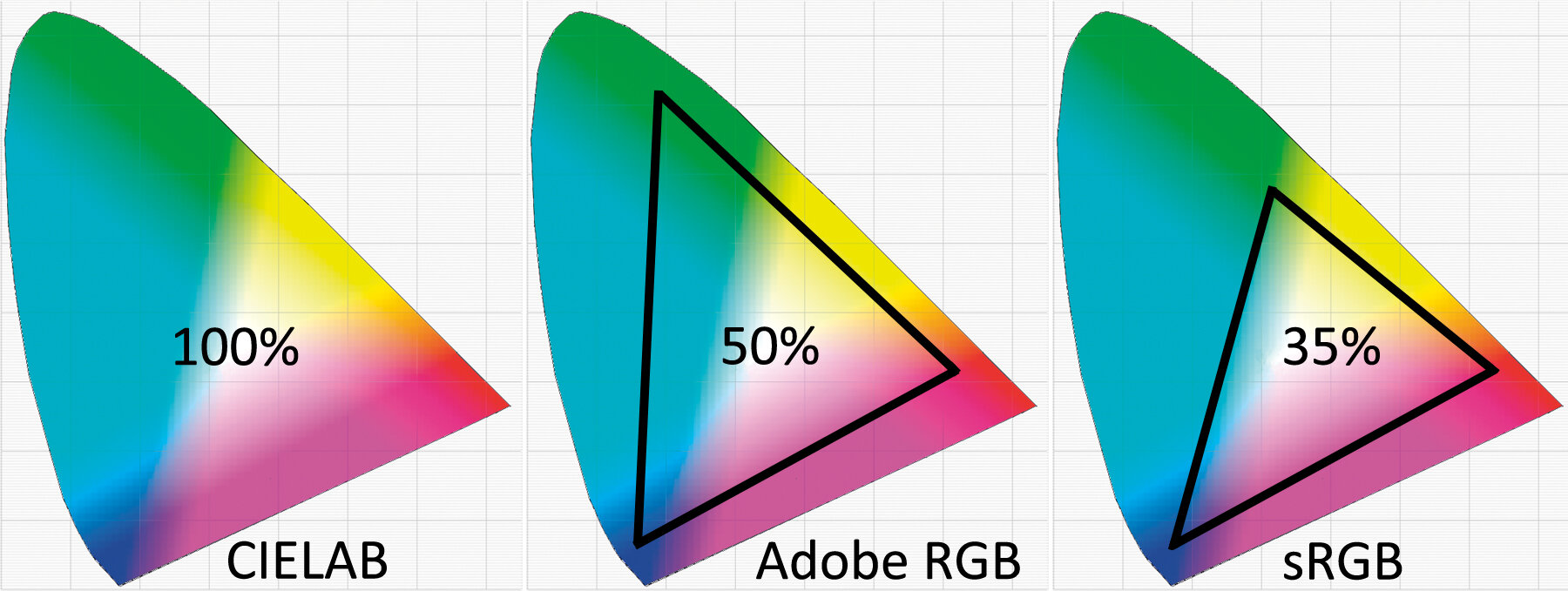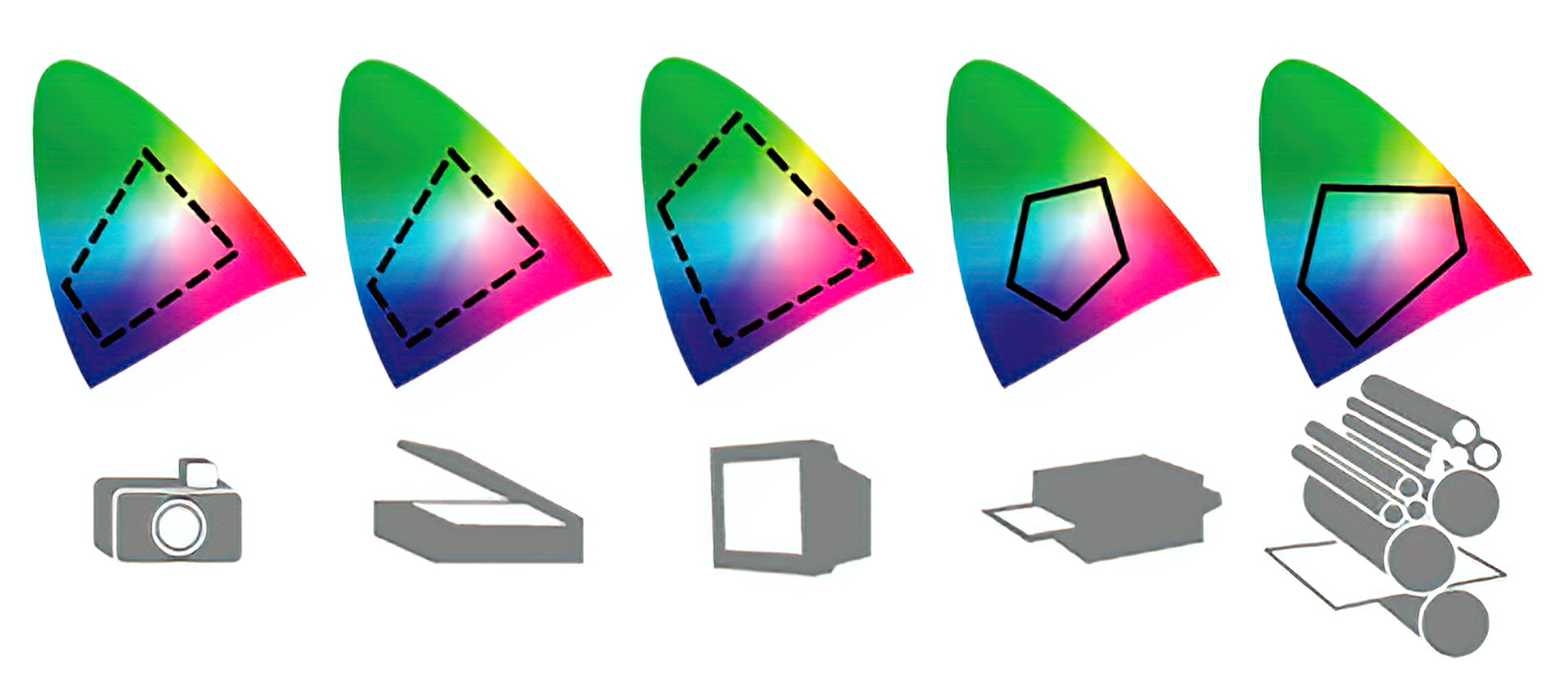Understanding Color Spaces in Photography
1. What is a Color Space?
A color space defines a standardized system for representing and reproducing colors within a specific range. When you capture an image with your camera, the color information needs to be interpreted and displayed across various devices — from home printers to professional displays. Think of it as a universal language that ensures your images maintain consistent and accurate colors across different platforms and devices, whether you’re viewing them on a smartphone screen or printing them at a photo lab.

The graphics industry uses CIELAB as a reference color space, which closely matches the full spectrum of colors visible to the human eye. Within this context, Adobe RGB — a popular color space for professional photography - encompasses approximately 50% of the CIELAB range, while sRGB covers about 35%. This wider “gamut” of Adobe RGB enables richer color reproduction, particularly in cyan and green tones. Color reproduction itself follows two main approaches: additive (RGB) used by digital devices like cameras and displays, and subtractive (CMYK) employed by printing systems. This fundamental difference in color handling plays a crucial role in how your images appear across different media.

2. Which Color Space Should You Choose?
The choice of color space for your photos primarily depends on their intended use and target platform. For professional publishing and commercial digital printing (such as books and magazines), Adobe RGB is the preferred choice as it maps excellently to the CMYK offset printing process. In contrast, sRGB’s limited color range makes it less suitable for CMYK conversion, potentially resulting in degraded output quality, particularly in images with subtle color gradients.
For everyday photography and consumer applications, sRGB is generally the optimal choice. This includes:
- Home printing on personal inkjet printers
- Web publishing and social media sharing
- Printing at retail photo kiosks
- Viewing on consumer displays
This widespread adoption of sRGB in consumer devices stems from its historical use in digital cameras and smartphones. While Adobe RGB theoretically offers a broader color range, many consumer-grade inkjet printers are specifically optimized for sRGB, potentially producing more vibrant prints with this color space. For online sharing, sRGB remains the de facto standard, ensuring optimal color reproduction across various devices and platforms.
Understanding JPEG color handling is also crucial. When creating a JPEG file, whether in-camera or through software, both Adobe RGB and sRGB color spaces are compressed to 256 levels per RGB channel. However, Adobe RGB’s wider initial color spectrum can provide more accurate color representation, especially in scenes with rich, diverse color palettes. This makes Adobe RGB particularly valuable for images that require precise color reproduction or extensive post-processing.
3. For RAW (NEF) shooters
When shooting in RAW (NEF) format, the choice of color space becomes less critical, as RAW files are essentially direct sensor data without an embedded color space. The color space setting in your camera primarily serves as a reference for preview display before the RAW file undergoes conversion to formats like JPEG. One of the key advantages of RAW photography is the flexibility to assign any color space during post-processing using RAW conversion software, without compromising image quality.
3.1 Color Management in Lightroom Classic and Camera Raw
Lightroom Classic employs a sophisticated color management system, primarily utilizing Adobe RGB for color display. This color space offers significant advantages, encompassing most camera-capturable colors and including printable colors - particularly cyans and blues - that exceed the limitations of the web-standard sRGB color space.
Lightroom Classic specifically applies Adobe RGB in several key areas:
- Module previews (Library, Map, Book, Slideshow, Print, and Web)
- Draft mode printing
- PDF slideshow exports and web gallery uploads
- Blurb.com book submissions (Note: PDF/JPEG exports from the Book module allow color profile selection)
- Social media publishing through the Publish Services panel
The Develop module takes color management a step further by defaulting to ProPhoto RGB, the most comprehensive color space available. This choice is particularly significant as ProPhoto RGB encompasses the entire spectrum of colors that modern digital cameras can capture, making it ideal for detailed image editing. The module also features Soft Proofing capabilities, allowing photographers to preview how their images will appear under various printing conditions.
For RAW photographers who regularly engage in post-processing, setting your camera to Adobe RGB offers a practical workflow advantage. However, the true benefit lies in the flexibility to select the most appropriate color space during final export, whether that’s sRGB for web display, Adobe RGB for professional printing, or ProPhoto RGB for maintaining maximum color information.
4. For JPEG and TIFF shooters
Color space selection is particularly crucial for JPEG and TIFF photographers, as these formats lock in the color space at the moment of capture. While it’s technically possible to adjust a JPEG’s color balance during post-processing, each re-compression degrades image quality, and significant color modifications often yield unsatisfactory results. For JPEG photography, achieving optimal color settings in-camera is paramount for superior image quality. Given JPEG’s limitations with extensive post-processing, it’s best treated as a finished product. For photographers seeking greater post-capture flexibility, RAW format offers a more versatile alternative.
When producing JPEG images for professional purposes, such as stock photography or print media, Adobe RGB is typically the required standard. Its expanded color gamut makes it particularly well-suited for commercial printing applications, ensuring optimal color reproduction across professional publishing platforms.